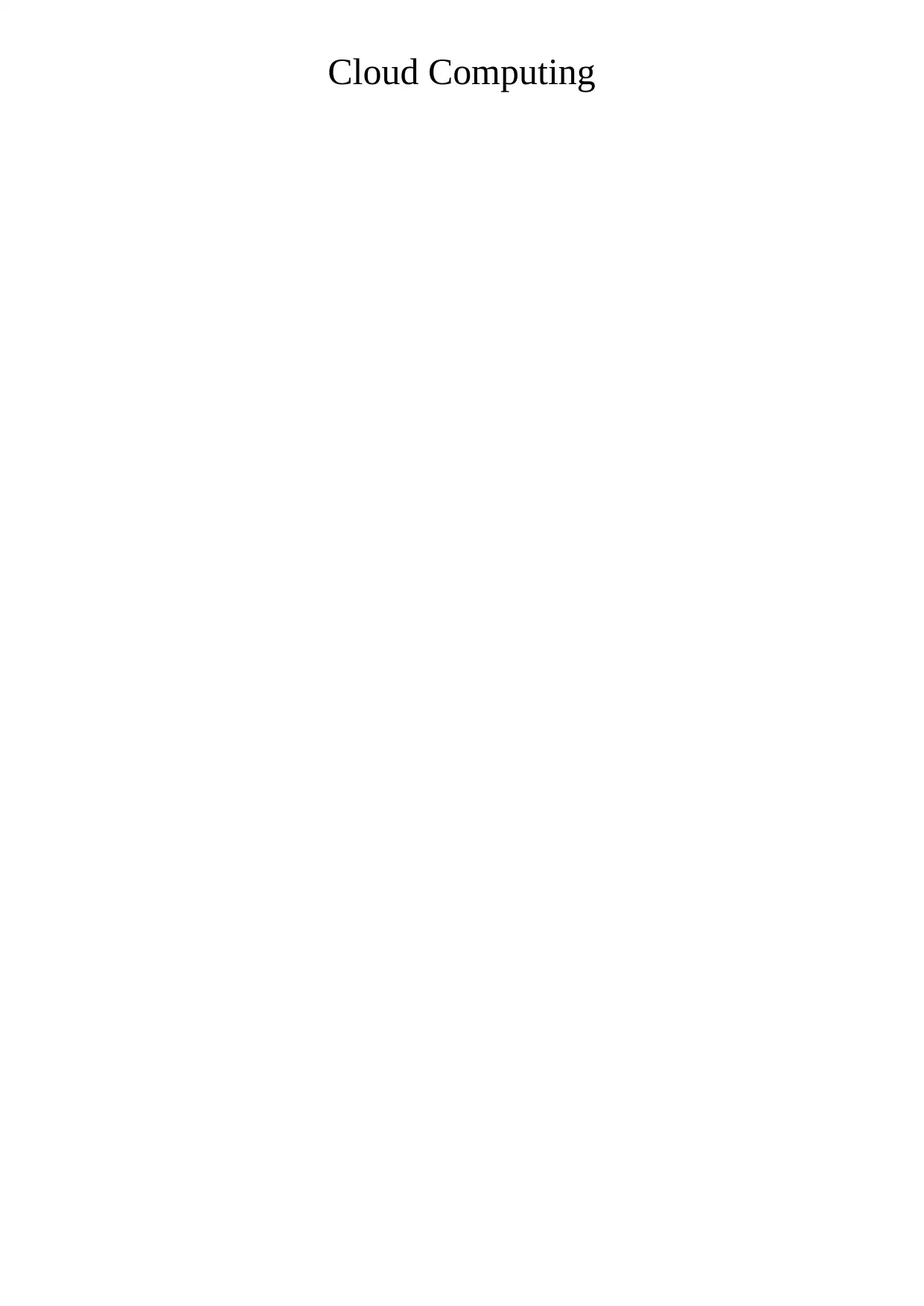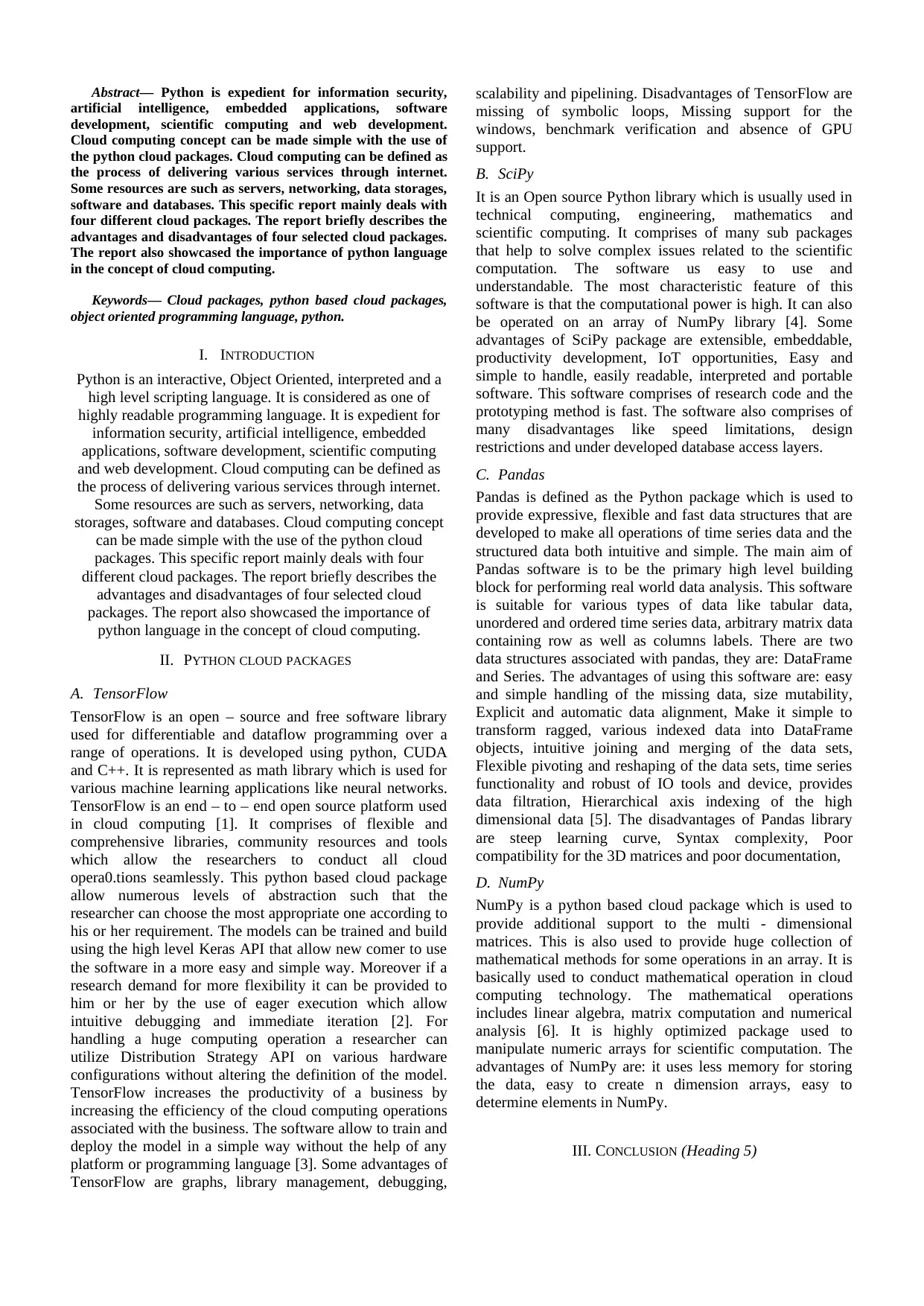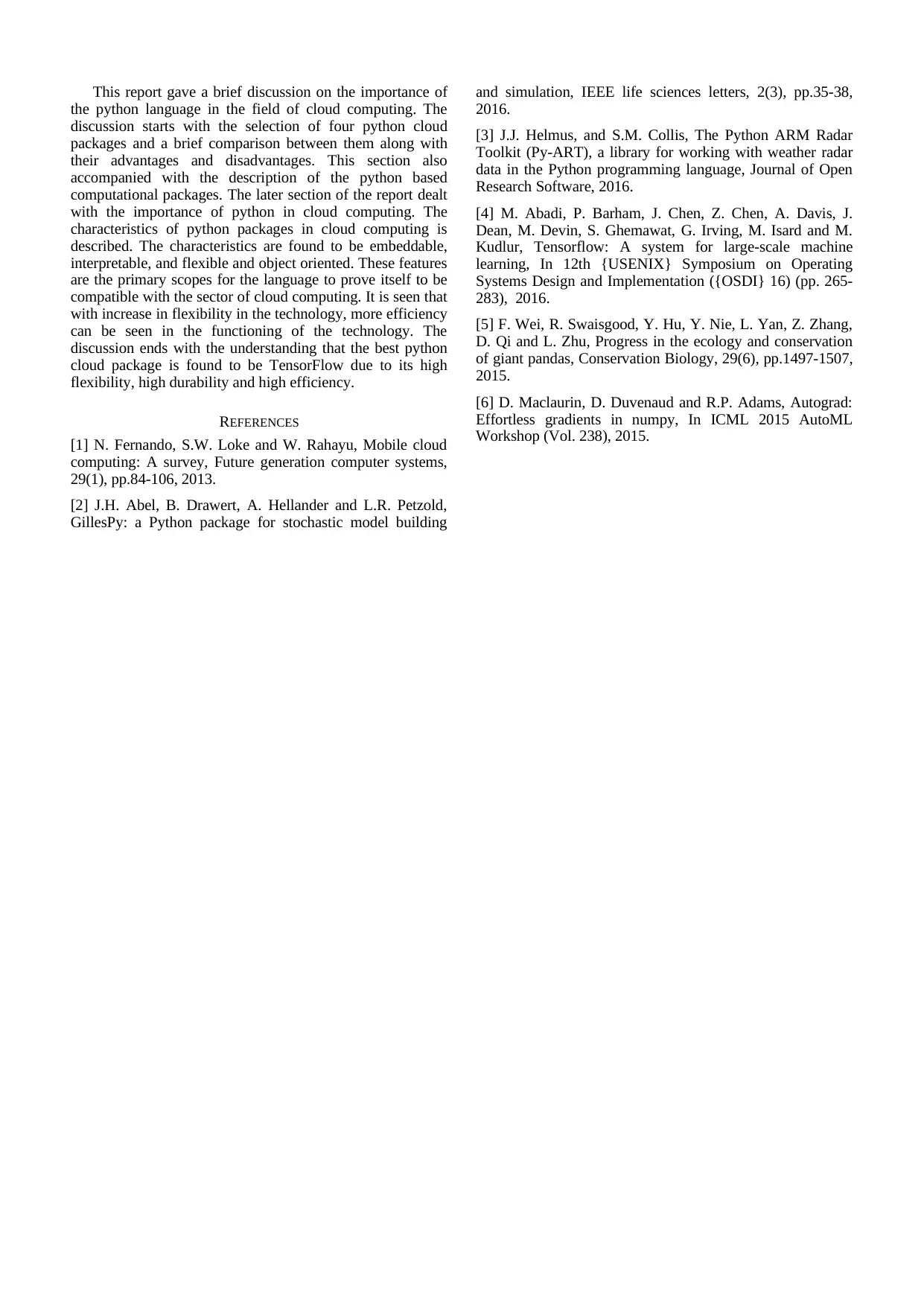Cloud Computing with Python: Package Analysis and Comparison
VerifiedAdded on 2022/10/08
|4
|1497
|16
Report
AI Summary
This report delves into the application of Python in cloud computing, examining four key cloud packages: TensorFlow, SciPy, Pandas, and NumPy. It begins by highlighting Python's versatility as an object-oriented, interpreted, and high-level scripting language, particularly its relevance to information security, artificial intelligence, and software development within cloud environments. The report provides detailed descriptions of each package, outlining their functionalities, advantages, and disadvantages. TensorFlow is presented as an open-source platform for machine learning, while SciPy is showcased for scientific and technical computing. Pandas is described as a tool for data analysis, and NumPy is emphasized for numerical operations. The report concludes by underscoring the importance of Python in cloud computing, particularly due to its flexibility, interpretability, and object-oriented nature, and suggests TensorFlow as a leading package due to its high efficiency and durability.

Cloud Computing
Paraphrase This Document
Need a fresh take? Get an instant paraphrase of this document with our AI Paraphraser

Abstract— Python is expedient for information security,
artificial intelligence, embedded applications, software
development, scientific computing and web development.
Cloud computing concept can be made simple with the use of
the python cloud packages. Cloud computing can be defined as
the process of delivering various services through internet.
Some resources are such as servers, networking, data storages,
software and databases. This specific report mainly deals with
four different cloud packages. The report briefly describes the
advantages and disadvantages of four selected cloud packages.
The report also showcased the importance of python language
in the concept of cloud computing.
Keywords— Cloud packages, python based cloud packages,
object oriented programming language, python.
I. INTRODUCTION
Python is an interactive, Object Oriented, interpreted and a
high level scripting language. It is considered as one of
highly readable programming language. It is expedient for
information security, artificial intelligence, embedded
applications, software development, scientific computing
and web development. Cloud computing can be defined as
the process of delivering various services through internet.
Some resources are such as servers, networking, data
storages, software and databases. Cloud computing concept
can be made simple with the use of the python cloud
packages. This specific report mainly deals with four
different cloud packages. The report briefly describes the
advantages and disadvantages of four selected cloud
packages. The report also showcased the importance of
python language in the concept of cloud computing.
II. PYTHON CLOUD PACKAGES
A. TensorFlow
TensorFlow is an open – source and free software library
used for differentiable and dataflow programming over a
range of operations. It is developed using python, CUDA
and C++. It is represented as math library which is used for
various machine learning applications like neural networks.
TensorFlow is an end – to – end open source platform used
in cloud computing [1]. It comprises of flexible and
comprehensive libraries, community resources and tools
which allow the researchers to conduct all cloud
opera0.tions seamlessly. This python based cloud package
allow numerous levels of abstraction such that the
researcher can choose the most appropriate one according to
his or her requirement. The models can be trained and build
using the high level Keras API that allow new comer to use
the software in a more easy and simple way. Moreover if a
research demand for more flexibility it can be provided to
him or her by the use of eager execution which allow
intuitive debugging and immediate iteration [2]. For
handling a huge computing operation a researcher can
utilize Distribution Strategy API on various hardware
configurations without altering the definition of the model.
TensorFlow increases the productivity of a business by
increasing the efficiency of the cloud computing operations
associated with the business. The software allow to train and
deploy the model in a simple way without the help of any
platform or programming language [3]. Some advantages of
TensorFlow are graphs, library management, debugging,
scalability and pipelining. Disadvantages of TensorFlow are
missing of symbolic loops, Missing support for the
windows, benchmark verification and absence of GPU
support.
B. SciPy
It is an Open source Python library which is usually used in
technical computing, engineering, mathematics and
scientific computing. It comprises of many sub packages
that help to solve complex issues related to the scientific
computation. The software us easy to use and
understandable. The most characteristic feature of this
software is that the computational power is high. It can also
be operated on an array of NumPy library [4]. Some
advantages of SciPy package are extensible, embeddable,
productivity development, IoT opportunities, Easy and
simple to handle, easily readable, interpreted and portable
software. This software comprises of research code and the
prototyping method is fast. The software also comprises of
many disadvantages like speed limitations, design
restrictions and under developed database access layers.
C. Pandas
Pandas is defined as the Python package which is used to
provide expressive, flexible and fast data structures that are
developed to make all operations of time series data and the
structured data both intuitive and simple. The main aim of
Pandas software is to be the primary high level building
block for performing real world data analysis. This software
is suitable for various types of data like tabular data,
unordered and ordered time series data, arbitrary matrix data
containing row as well as columns labels. There are two
data structures associated with pandas, they are: DataFrame
and Series. The advantages of using this software are: easy
and simple handling of the missing data, size mutability,
Explicit and automatic data alignment, Make it simple to
transform ragged, various indexed data into DataFrame
objects, intuitive joining and merging of the data sets,
Flexible pivoting and reshaping of the data sets, time series
functionality and robust of IO tools and device, provides
data filtration, Hierarchical axis indexing of the high
dimensional data [5]. The disadvantages of Pandas library
are steep learning curve, Syntax complexity, Poor
compatibility for the 3D matrices and poor documentation,
D. NumPy
NumPy is a python based cloud package which is used to
provide additional support to the multi - dimensional
matrices. This is also used to provide huge collection of
mathematical methods for some operations in an array. It is
basically used to conduct mathematical operation in cloud
computing technology. The mathematical operations
includes linear algebra, matrix computation and numerical
analysis [6]. It is highly optimized package used to
manipulate numeric arrays for scientific computation. The
advantages of NumPy are: it uses less memory for storing
the data, easy to create n dimension arrays, easy to
determine elements in NumPy.
III. CONCLUSION (Heading 5)
artificial intelligence, embedded applications, software
development, scientific computing and web development.
Cloud computing concept can be made simple with the use of
the python cloud packages. Cloud computing can be defined as
the process of delivering various services through internet.
Some resources are such as servers, networking, data storages,
software and databases. This specific report mainly deals with
four different cloud packages. The report briefly describes the
advantages and disadvantages of four selected cloud packages.
The report also showcased the importance of python language
in the concept of cloud computing.
Keywords— Cloud packages, python based cloud packages,
object oriented programming language, python.
I. INTRODUCTION
Python is an interactive, Object Oriented, interpreted and a
high level scripting language. It is considered as one of
highly readable programming language. It is expedient for
information security, artificial intelligence, embedded
applications, software development, scientific computing
and web development. Cloud computing can be defined as
the process of delivering various services through internet.
Some resources are such as servers, networking, data
storages, software and databases. Cloud computing concept
can be made simple with the use of the python cloud
packages. This specific report mainly deals with four
different cloud packages. The report briefly describes the
advantages and disadvantages of four selected cloud
packages. The report also showcased the importance of
python language in the concept of cloud computing.
II. PYTHON CLOUD PACKAGES
A. TensorFlow
TensorFlow is an open – source and free software library
used for differentiable and dataflow programming over a
range of operations. It is developed using python, CUDA
and C++. It is represented as math library which is used for
various machine learning applications like neural networks.
TensorFlow is an end – to – end open source platform used
in cloud computing [1]. It comprises of flexible and
comprehensive libraries, community resources and tools
which allow the researchers to conduct all cloud
opera0.tions seamlessly. This python based cloud package
allow numerous levels of abstraction such that the
researcher can choose the most appropriate one according to
his or her requirement. The models can be trained and build
using the high level Keras API that allow new comer to use
the software in a more easy and simple way. Moreover if a
research demand for more flexibility it can be provided to
him or her by the use of eager execution which allow
intuitive debugging and immediate iteration [2]. For
handling a huge computing operation a researcher can
utilize Distribution Strategy API on various hardware
configurations without altering the definition of the model.
TensorFlow increases the productivity of a business by
increasing the efficiency of the cloud computing operations
associated with the business. The software allow to train and
deploy the model in a simple way without the help of any
platform or programming language [3]. Some advantages of
TensorFlow are graphs, library management, debugging,
scalability and pipelining. Disadvantages of TensorFlow are
missing of symbolic loops, Missing support for the
windows, benchmark verification and absence of GPU
support.
B. SciPy
It is an Open source Python library which is usually used in
technical computing, engineering, mathematics and
scientific computing. It comprises of many sub packages
that help to solve complex issues related to the scientific
computation. The software us easy to use and
understandable. The most characteristic feature of this
software is that the computational power is high. It can also
be operated on an array of NumPy library [4]. Some
advantages of SciPy package are extensible, embeddable,
productivity development, IoT opportunities, Easy and
simple to handle, easily readable, interpreted and portable
software. This software comprises of research code and the
prototyping method is fast. The software also comprises of
many disadvantages like speed limitations, design
restrictions and under developed database access layers.
C. Pandas
Pandas is defined as the Python package which is used to
provide expressive, flexible and fast data structures that are
developed to make all operations of time series data and the
structured data both intuitive and simple. The main aim of
Pandas software is to be the primary high level building
block for performing real world data analysis. This software
is suitable for various types of data like tabular data,
unordered and ordered time series data, arbitrary matrix data
containing row as well as columns labels. There are two
data structures associated with pandas, they are: DataFrame
and Series. The advantages of using this software are: easy
and simple handling of the missing data, size mutability,
Explicit and automatic data alignment, Make it simple to
transform ragged, various indexed data into DataFrame
objects, intuitive joining and merging of the data sets,
Flexible pivoting and reshaping of the data sets, time series
functionality and robust of IO tools and device, provides
data filtration, Hierarchical axis indexing of the high
dimensional data [5]. The disadvantages of Pandas library
are steep learning curve, Syntax complexity, Poor
compatibility for the 3D matrices and poor documentation,
D. NumPy
NumPy is a python based cloud package which is used to
provide additional support to the multi - dimensional
matrices. This is also used to provide huge collection of
mathematical methods for some operations in an array. It is
basically used to conduct mathematical operation in cloud
computing technology. The mathematical operations
includes linear algebra, matrix computation and numerical
analysis [6]. It is highly optimized package used to
manipulate numeric arrays for scientific computation. The
advantages of NumPy are: it uses less memory for storing
the data, easy to create n dimension arrays, easy to
determine elements in NumPy.
III. CONCLUSION (Heading 5)

This report gave a brief discussion on the importance of
the python language in the field of cloud computing. The
discussion starts with the selection of four python cloud
packages and a brief comparison between them along with
their advantages and disadvantages. This section also
accompanied with the description of the python based
computational packages. The later section of the report dealt
with the importance of python in cloud computing. The
characteristics of python packages in cloud computing is
described. The characteristics are found to be embeddable,
interpretable, and flexible and object oriented. These features
are the primary scopes for the language to prove itself to be
compatible with the sector of cloud computing. It is seen that
with increase in flexibility in the technology, more efficiency
can be seen in the functioning of the technology. The
discussion ends with the understanding that the best python
cloud package is found to be TensorFlow due to its high
flexibility, high durability and high efficiency.
REFERENCES
[1] N. Fernando, S.W. Loke and W. Rahayu, Mobile cloud
computing: A survey, Future generation computer systems,
29(1), pp.84-106, 2013.
[2] J.H. Abel, B. Drawert, A. Hellander and L.R. Petzold,
GillesPy: a Python package for stochastic model building
and simulation, IEEE life sciences letters, 2(3), pp.35-38,
2016.
[3] J.J. Helmus, and S.M. Collis, The Python ARM Radar
Toolkit (Py-ART), a library for working with weather radar
data in the Python programming language, Journal of Open
Research Software, 2016.
[4] M. Abadi, P. Barham, J. Chen, Z. Chen, A. Davis, J.
Dean, M. Devin, S. Ghemawat, G. Irving, M. Isard and M.
Kudlur, Tensorflow: A system for large-scale machine
learning, In 12th {USENIX} Symposium on Operating
Systems Design and Implementation ({OSDI} 16) (pp. 265-
283), 2016.
[5] F. Wei, R. Swaisgood, Y. Hu, Y. Nie, L. Yan, Z. Zhang,
D. Qi and L. Zhu, Progress in the ecology and conservation
of giant pandas, Conservation Biology, 29(6), pp.1497-1507,
2015.
[6] D. Maclaurin, D. Duvenaud and R.P. Adams, Autograd:
Effortless gradients in numpy, In ICML 2015 AutoML
Workshop (Vol. 238), 2015.
the python language in the field of cloud computing. The
discussion starts with the selection of four python cloud
packages and a brief comparison between them along with
their advantages and disadvantages. This section also
accompanied with the description of the python based
computational packages. The later section of the report dealt
with the importance of python in cloud computing. The
characteristics of python packages in cloud computing is
described. The characteristics are found to be embeddable,
interpretable, and flexible and object oriented. These features
are the primary scopes for the language to prove itself to be
compatible with the sector of cloud computing. It is seen that
with increase in flexibility in the technology, more efficiency
can be seen in the functioning of the technology. The
discussion ends with the understanding that the best python
cloud package is found to be TensorFlow due to its high
flexibility, high durability and high efficiency.
REFERENCES
[1] N. Fernando, S.W. Loke and W. Rahayu, Mobile cloud
computing: A survey, Future generation computer systems,
29(1), pp.84-106, 2013.
[2] J.H. Abel, B. Drawert, A. Hellander and L.R. Petzold,
GillesPy: a Python package for stochastic model building
and simulation, IEEE life sciences letters, 2(3), pp.35-38,
2016.
[3] J.J. Helmus, and S.M. Collis, The Python ARM Radar
Toolkit (Py-ART), a library for working with weather radar
data in the Python programming language, Journal of Open
Research Software, 2016.
[4] M. Abadi, P. Barham, J. Chen, Z. Chen, A. Davis, J.
Dean, M. Devin, S. Ghemawat, G. Irving, M. Isard and M.
Kudlur, Tensorflow: A system for large-scale machine
learning, In 12th {USENIX} Symposium on Operating
Systems Design and Implementation ({OSDI} 16) (pp. 265-
283), 2016.
[5] F. Wei, R. Swaisgood, Y. Hu, Y. Nie, L. Yan, Z. Zhang,
D. Qi and L. Zhu, Progress in the ecology and conservation
of giant pandas, Conservation Biology, 29(6), pp.1497-1507,
2015.
[6] D. Maclaurin, D. Duvenaud and R.P. Adams, Autograd:
Effortless gradients in numpy, In ICML 2015 AutoML
Workshop (Vol. 238), 2015.
⊘ This is a preview!⊘
Do you want full access?
Subscribe today to unlock all pages.

Trusted by 1+ million students worldwide

1 out of 4
Related Documents
Your All-in-One AI-Powered Toolkit for Academic Success.
+13062052269
info@desklib.com
Available 24*7 on WhatsApp / Email
![[object Object]](/_next/static/media/star-bottom.7253800d.svg)
Unlock your academic potential
Copyright © 2020–2025 A2Z Services. All Rights Reserved. Developed and managed by ZUCOL.




